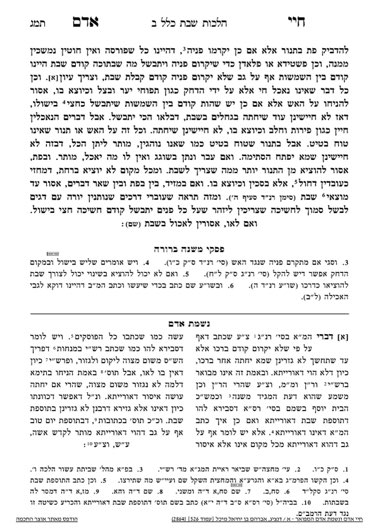We are continuing in siman 3, discussing putting up food before Shabbos to cook into Shabbos. The Chayei Adam writes that the halachos of shehiyah apply not only to foods which cannot be eaten raw, but even to foods which can be eaten raw, but are not easily eaten raw. If the food is easily eaten raw, the concern of Chazal does not apply, because there is less of a concern that one will stir the coals since it can anyways be eaten in its current state.
However, the Chayei Adam writes that if the food can be eaten raw, but is much easier to eat when cooked, the issur of shehiyah still applies.
The next point. We learned that the Chayei Adam paskens that a food item to which the issurim of shehiyah apply must be edible before the onset of Shabbos. The Chayei Adam clarifies that “edible” is defined as chatzi bishulo, half cooked before Shabbos.
Figuring out the precise timing of chatzi bishulo can be difficult. The Chazon Ish suggests a method for calculating this amount. Let us use an example of a food item which takes 40 minutes to cook. In the first five minutes, the food is not actually cooking, but warming up to reach a cooking temperature (yad soledes). If so, the cooking process takes 35 minutes. Half that amount of time is defined as chatzi bishulo, so to reach chatzi bishulo for such a food, one would have to place it on the fire 22.5 minutes before the onset of Shabbos. Once the food has reached chatzi bishulo, Chazal were less concerned that a person would stir the coals, because it is usable as-is, and because there is more of a reason for the person to leave the item and assume it will be fine without any intervention.
Chatzi bishulo is based on the Rambam’s understanding of maachal Ben Derusai. Ben Derusai was a bandit who was always running from the authorities. He could not remain in one place for long enough to fully cook his food, so he would eat it semi-cooked. Chazal used his definition of cooked as the benchmark for what was considered edible. Although the Rambam understood his benchmark to be when the item was half cooked, Rashi understood it to be when it was one third cooked. The Mishnah Berurah writes that one can rely on the opinion of Rashi in a case of necessity. If so, going back to our example, 35 would be divided by three, so one would have to put up the food item at least 17 minutes (11.6 + 5 for warm up) before the onset of Shabbos. However, one must remember that one should only rely on the one third opinion in a case of necessity.
As we learned, the issur of shehiyah applies to foods which are inedible raw, or edible raw with difficulty. It does not apply to foods which are easily edible when raw, as we will discuss further in the upcoming shiur, be’ezras Hashem.
Summary
- The issur of shehiyah only applies to foods which are inedible raw or edible raw with difficulty.
- Such a food must be minimally edible before Shabbos. Minimally edible is defined as half cooked, or, in cases of necessity, one third cooked.
- These amounts are timed by subtracting the amount of time it takes for the food to reach cooking temperature, dividing by two (or three, in necessity), and adding those numbers together.



